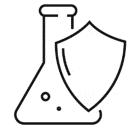Hexagonal Boron Nitride (h-BN) components offer several unique advantages due to their distinctive properties:

Low Coefficient of Friction:
h-BN is an excellent lubricant, reducing wear and tear in moving parts.

Thermal Stability:

Thermal Shock Resistance:

Chemical Inertness:

Electrical Insulation:

Non-Toxic:

Anisotropic Properties:
These properties make hexagonal Boron Nitride components highly valuable for the following applications:
High-Temperature Furnace Insulators:
h-BN is used as an insulator in high-temperature furnaces due to its excellent thermal stability and electrical insulation properties.
Protective Tubes and Insulating Sleeves:
It is used in protective tubes and insulating sleeves for thermocouples, for the temperature measurement in various industrial processes.
Pyrolytic Boron Nitride Crucibles:
h-BN is used to make crucibles for high-temperature applications, such as in the production of advanced materials (i.e. semiconductor industry).
Break Rings for Steel Casting:
It is used in break rings for the horizontal continuous casting of steel, providing durability and resistance to high temperatures.
Photonic Devices:
h-BN is used in photonic devices, including deep ultraviolet (DUV) light-emitting diodes (LEDs) and photodetectors, as well as infrared (IR) absorbers/emitters and hyperlenses.
Barrier Layers:
Due to its impermeability and non-reactivity, h-BN is used as a protective barrier to prevent corrosion and oxidation of metals.
Advanced Electronics:
h-BN serves as an ideal substrate for graphene-based devices, enhancing their performance by providing a smooth, insulating surface

